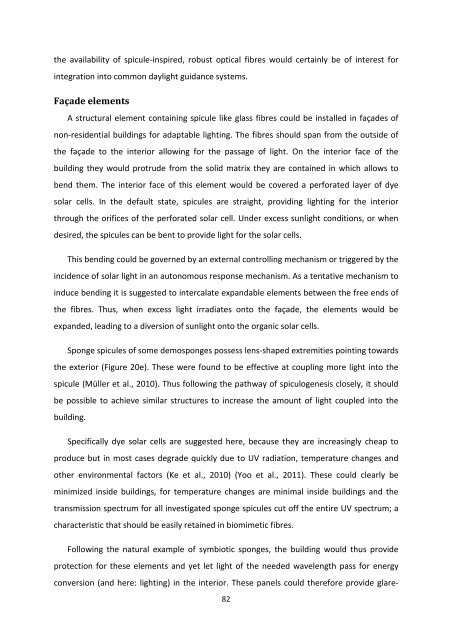MASTER THESIS Biomimetic potential of sponge ... - IAP/TU Wien
MASTER THESIS Biomimetic potential of sponge ... - IAP/TU Wien
MASTER THESIS Biomimetic potential of sponge ... - IAP/TU Wien
Create successful ePaper yourself
Turn your PDF publications into a flip-book with our unique Google optimized e-Paper software.
the availability <strong>of</strong> spicule-inspired, robust optical fibres would certainly be <strong>of</strong> interest for<br />
integration into common daylight guidance systems.<br />
Façade elements<br />
A structural element containing spicule like glass fibres could be installed in façades <strong>of</strong><br />
non-residential buildings for adaptable lighting. The fibres should span from the outside <strong>of</strong><br />
the façade to the interior allowing for the passage <strong>of</strong> light. On the interior face <strong>of</strong> the<br />
building they would protrude from the solid matrix they are contained in which allows to<br />
bend them. The interior face <strong>of</strong> this element would be covered a perforated layer <strong>of</strong> dye<br />
solar cells. In the default state, spicules are straight, providing lighting for the interior<br />
through the orifices <strong>of</strong> the perforated solar cell. Under excess sunlight conditions, or when<br />
desired, the spicules can be bent to provide light for the solar cells.<br />
This bending could be governed by an external controlling mechanism or triggered by the<br />
incidence <strong>of</strong> solar light in an autonomous response mechanism. As a tentative mechanism to<br />
induce bending it is suggested to intercalate expandable elements between the free ends <strong>of</strong><br />
the fibres. Thus, when excess light irradiates onto the façade, the elements would be<br />
expanded, leading to a diversion <strong>of</strong> sunlight onto the organic solar cells.<br />
Sponge spicules <strong>of</strong> some demo<strong>sponge</strong>s possess lens-shaped extremities pointing towards<br />
the exterior (Figure 20e). These were found to be effective at coupling more light into the<br />
spicule (Müller et al., 2010). Thus following the pathway <strong>of</strong> spiculogenesis closely, it should<br />
be possible to achieve similar structures to increase the amount <strong>of</strong> light coupled into the<br />
building.<br />
Specifically dye solar cells are suggested here, because they are increasingly cheap to<br />
produce but in most cases degrade quickly due to UV radiation, temperature changes and<br />
other environmental factors (Ke et al., 2010) (Yoo et al., 2011). These could clearly be<br />
minimized inside buildings, for temperature changes are minimal inside buildings and the<br />
transmission spectrum for all investigated <strong>sponge</strong> spicules cut <strong>of</strong>f the entire UV spectrum; a<br />
characteristic that should be easily retained in biomimetic fibres.<br />
Following the natural example <strong>of</strong> symbiotic <strong>sponge</strong>s, the building would thus provide<br />
protection for these elements and yet let light <strong>of</strong> the needed wavelength pass for energy<br />
conversion (and here: lighting) in the interior. These panels could therefore provide glare-<br />
82

















